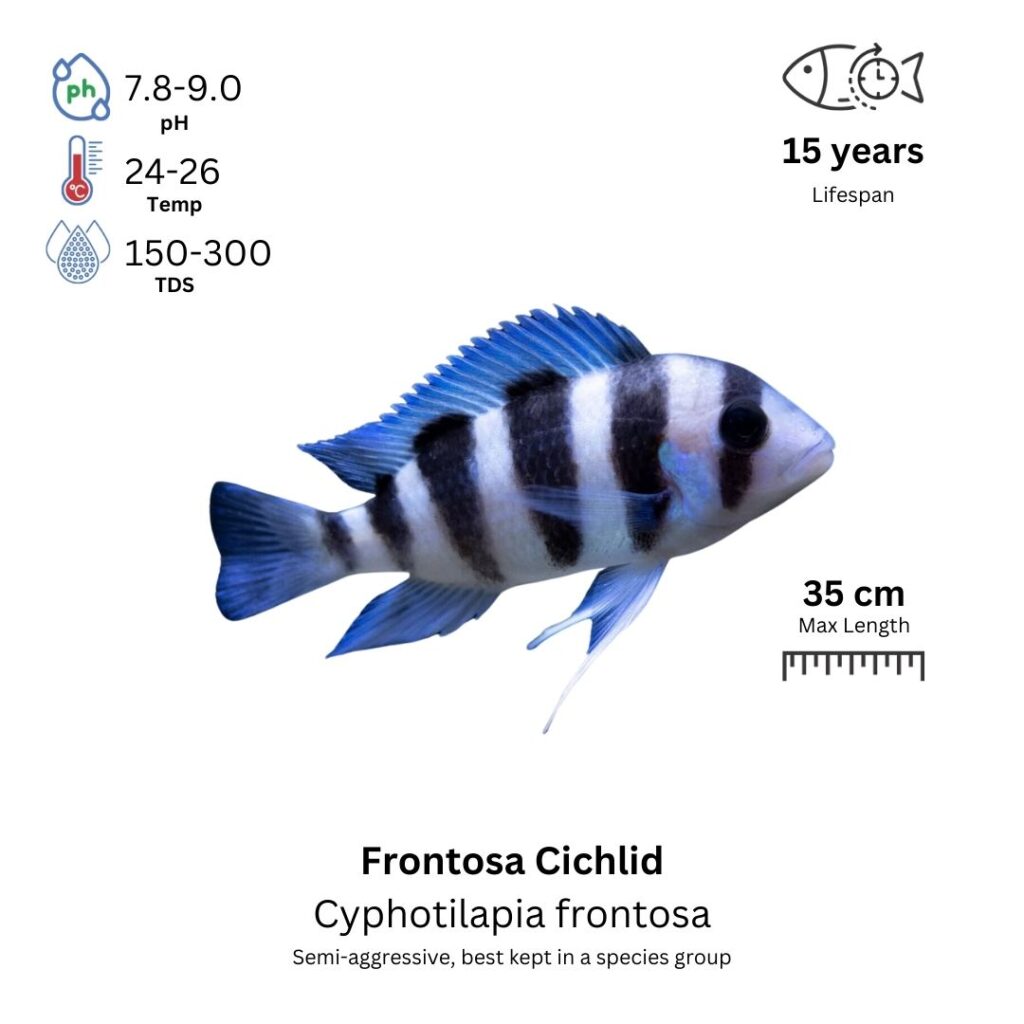Frontosa Cichlid
Cyphotilapia frontosa

Description
The Frontosa Cichlid is a strikingly large and robust species of cichlid, known for its impressive size and unique appearance. The most distinguishing feature of the Frontosa Cichlid is its large, prominent forehead, which is especially noticeable in males. This large “hump” is actually a fat-filled area on the fish’s head that grows larger as the fish matures. The body is elongated and somewhat laterally compressed, with a smooth, silvery to blue-gray coloration, often with darker markings around the head, body, and fins. The fins are large and well-developed, contributing to the fish’s graceful swimming ability. These cichlids are territorial and can be aggressive, particularly during breeding, but they are generally peaceful when kept in a species-specific tank or with other large, non-aggressive species.
Habitat Origin
Native to the rocky shorelines of Lake Tanganyika in East Africa. These cichlids are found in deep, rocky areas of the lake where they inhabit caves and crevices in the rocks. They prefer slightly alkaline water with high mineral content and require clean, well-oxygenated water. The natural habitat of Frontosa Cichlids consists of clear water with gentle to moderate currents, often with an abundance of rocks for hiding and establishing territories.
Aquarium
Ideal Number in Aquarium: Best kept singly or in pairs. A group of Frontosas should be kept in a large tank with plenty of space to establish territories. Keeping them with other large, peaceful species is ideal.
Favorite Food

Frontosa Cichlids are carnivorous and will accept a variety of protein-rich foods. In the wild, they feed on smaller fish, invertebrates, and crustaceans. In captivity, they can be fed high-quality pellets, freeze-dried or frozen foods such as shrimp, bloodworms, and other meaty foods. Occasionally, they can be offered live foods like small fish or insects. It’s important to provide a high-protein diet to maintain their health and vibrant coloration.
Behavior:
Frontosa Cichlids are territorial, particularly males, and may exhibit aggressive behavior toward other fish that invade their territory, especially during breeding. They are not overly aggressive toward tankmates but should not be housed with smaller or more timid species. Frontosas are known to dig and rearrange substrate, so providing a tank with rocks and caves will help them feel secure and establish their territories. They are relatively peaceful toward each other, especially when kept in large aquariums with adequate space. However, they can become aggressive during the breeding season.
Special Care:
Frontosa Cichlids require a well-maintained aquarium with stable water parameters. They thrive in hard, alkaline water, so it is essential to ensure that the tank’s pH and hardness levels are appropriate. Regular water changes, good filtration, and a large tank with plenty of hiding spots are critical to their health and well-being. The tank should be well-equipped with rocks and caves to allow the Frontosa Cichlids to establish territories and feel secure. Since they are large fish, a spacious aquarium is crucial to avoid overcrowding and minimize aggression.
Compatibility with Other Fish:
Frontosa Cichlids are best kept with other large, peaceful species that can tolerate their territorial nature. They can be housed with other cichlids from Lake Tanganyika, but care should be taken to ensure that the tankmates are similarly sized and non-aggressive. Smaller, peaceful fish are not suitable tankmates, as they may be bullied or preyed upon. Frontosas are not typically good community fish but do well in a species-specific tank or with other robust, non-aggressive species.
Breeding Setup
Setting up a separate breeding tank is highly recommended for Frontosa Cichlids due to their territorial nature. A 200-liter (50-gallon) tank is ideal for a breeding pair, offering enough space for natural behaviors and territorial separation. Maintain pH 7.5–8.5, temperature 24–28°C, and GH 10–15 dGH. Use a strong but gentle-flow filter, such as a sponge or canister filter. The substrate should include rocks and caves to replicate their natural rocky lake environment. Moderate lighting that mimics natural daylight is best, as they prefer subdued light.
Conditioning for Breeding
Frontosas need to be well-conditioned before breeding. Feed them a high-protein, varied diet, including high-quality cichlid pellets, live brine shrimp, bloodworms, daphnia, and frozen foods. A rich diet helps females develop healthy eggs and enhances the male’s breeding behavior. Perform weekly 25% water changes to maintain optimal water quality, which is crucial for triggering and sustaining breeding activity.
Spawning Process
Frontosa Cichlids are maternal mouthbrooders. The male will court the female by flaring his fins and displaying vibrant colors. Once the female lays 50–100 eggs, she gathers them into her mouth, where the male fertilizes them. The female incubates the eggs in her mouth for about 3–4 weeks, during which she does not eat. After this period, she releases fully formed fry into the tank. Males may continue to guard the area, though the primary responsibility lies with the female.
Fry Care
The incubation period lasts around 21–28 days, depending on temperature. After hatching, the fry stay in the female’s mouth until they are strong enough to swim. Once free-swimming, they should be fed infusoria, liquid fry food, or rotifers, then baby brine shrimp or finely crushed cichlid pellets as they grow. Maintain stable water conditions and perform daily 10–15% water changes. Ensure the fry are protected from tankmates and have plenty of hiding spaces for safety and stress reduction.
Important Notes
Frontosa Cichlids reach breeding maturity at 2–3 years. Males are larger, more colorful, and more assertive, especially during breeding, while females are rounder, especially when holding eggs. Avoid stress by providing ample caves and territories, minimizing aggression and maintaining a peaceful tank environment. Stability in water parameters and social conditions is essential for successful breeding and healthy fry development.
